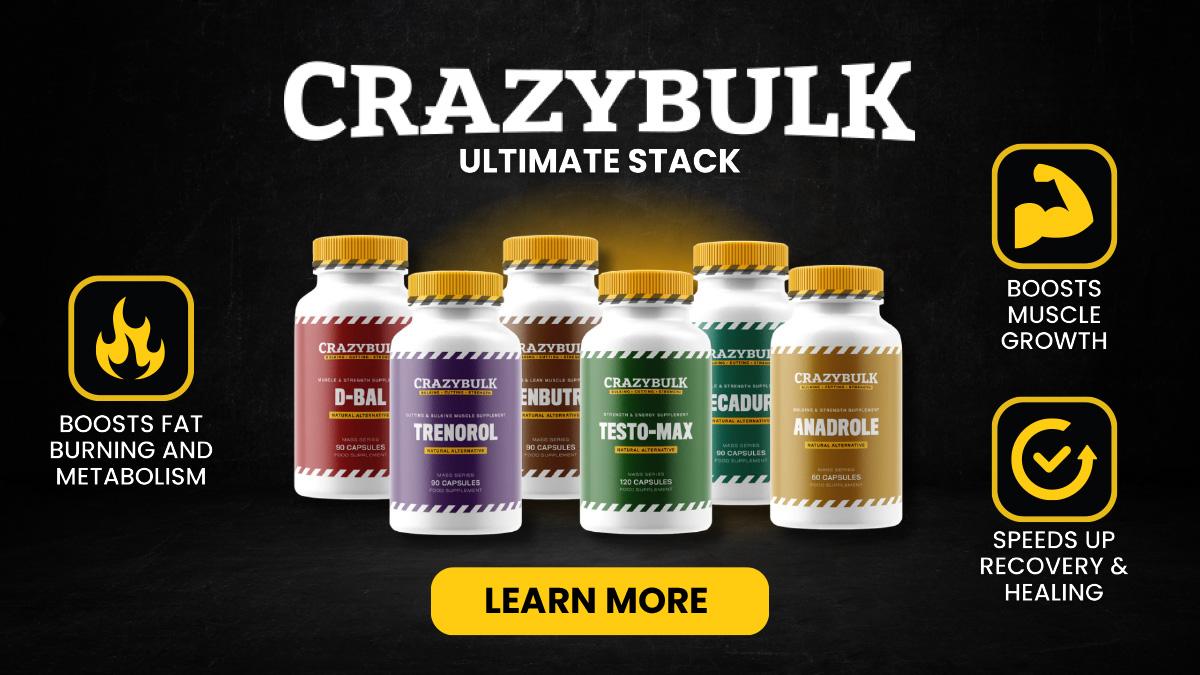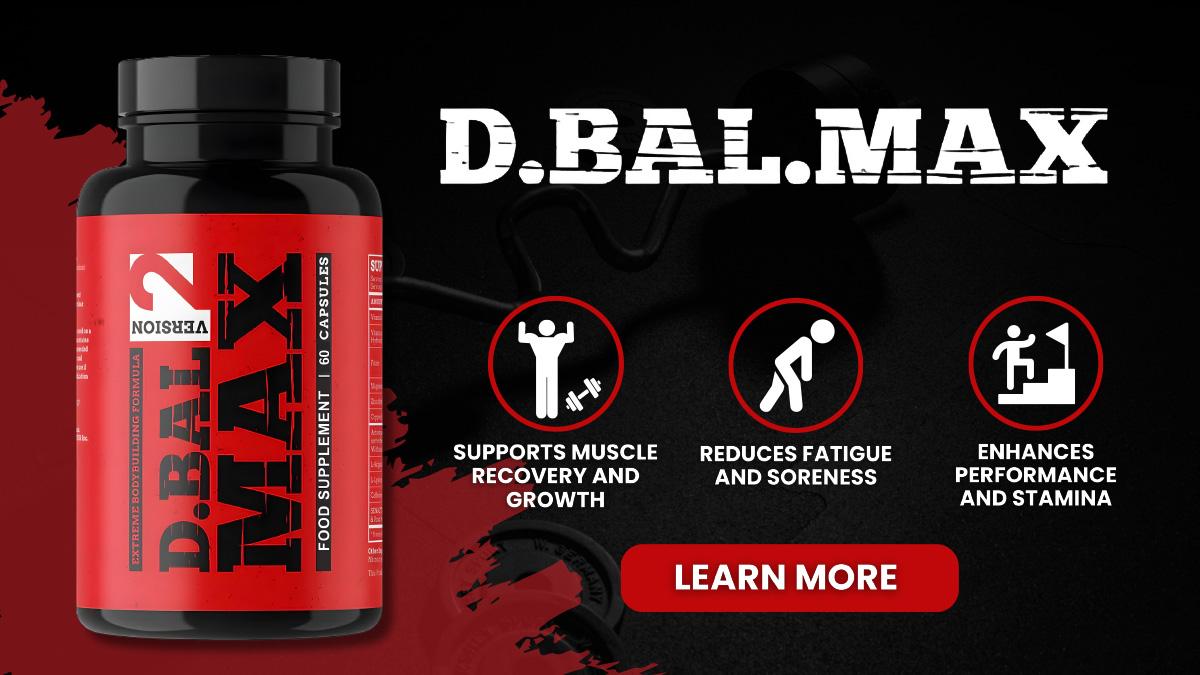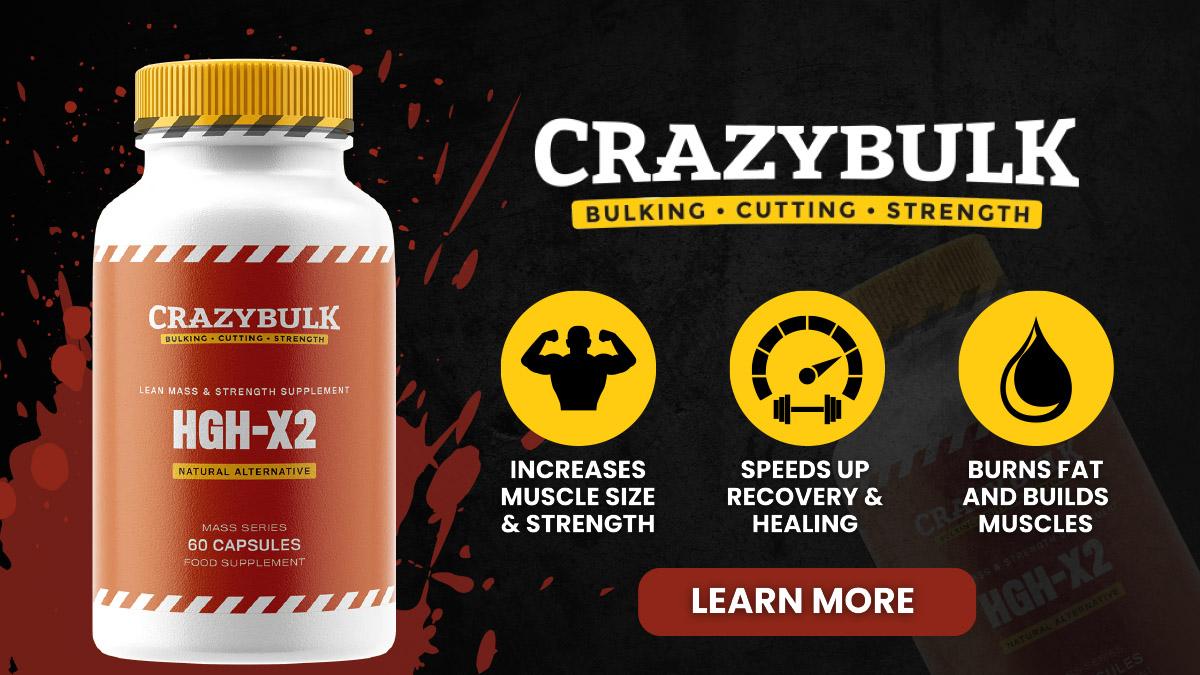Health
What Are Steroids Used For? Types, Side Effects, and Alternatives

Steroids, often misunderstood, are powerhouse compounds used for a myriad of purposes. From battling chronic conditions to boosting athletic performance, they’re not just synonymous with gym jargon but are medical marvels when used responsibly.
Embracing their potential, yet acknowledging the need for informed usage, unlocks their true value. Plus, we’ve uncovered natural and legal alternatives like CrazyBulk that offer benefits without the controversy associated with illegal steroids.
Types of Steroids
There are legal and illegal steroids, and the distinction between them is based on their legal status when it comes to regulation and their intended use. Here’s a quick overview:
Legal Steroids
Legal steroids are dietary supplements that come packed with natural ingredients and stand legally available for purchase without prescription. Mimicking the effects of anabolic steroids without using any synthetic hormones or controlled substances is their formulation’s hallmark.
As alternatives to anabolic steroids, legal steroids aim to bolster muscle growth, strength gains, and athletic prowess. Take, for instance, natural testosterone boosters, protein supplements, amino acid complexes, and herbal extracts—all are believed to turbocharge physical performance.
Illegal Steroids
Illegal steroids are synthetic drugs whose possession, use, or distribution without a licensed healthcare professional’s subscription stands as illegal. Anabolic steroids and their derivatives often fall under this category.
Athletes and bodybuilders looking for aesthetic enhancement to have an edge over their competitors might turn to these substances, regulated due to their abuse potential and adverse health impacts. Such non-medical use brings with it hefty legal and health risks.
Consider these examples:
- Testosterone enanthate
- Nandrolone decanoate (Deca-Durabolin)
- Stanozolol (Winstrol)
Though touted as safer, legal steroids may still harbor risks and side effects, particularly when misused or consumed in hefty doses. Their efficacy can also swing widely. Hence, consulting a healthcare professional before embarking on any new supplement journey is paramount, especially for those dealing with health issues.
>>Get stronger naturally with CrazyBulk Ultimate Stack
Best Legal Steroids
We made a quick list reviewing the top legal steroid alternatives available in 2024.
1. CrazyBulk Ultimate Stack
The CrazyBulk Ultimate Stack combines several legal steroid alternatives offered by the company, CrazyBulk. These supplements are designed to mimic the effects of anabolic steroids without the harmful side effects.
Each product in the Ultimate Stack is formulated with natural ingredients that are believed to help boost muscle growth, increase strength, enhance performance, and improve recovery time. These supplements are intended to be combined to provide synergistic effects and maximize results.
It’s important to note that while CrazyBulk markets its products as top alternatives to anabolic steroids, they are not actual steroids and do not contain any illegal or controlled substances.
Ingredients
- D-Bal (Dianabol alternative): Key ingredients include isoleucine, whey protein concentrate, valine, tribulus terrestris, and leucine. These ingredients support protein synthesis, muscle growth, and strength gains.
- Testo-Max (Sustanon alternative): Includes D-aspartic acid, fenugreek extract, nettle leaf extract, and ginseng. These ingredients are thought to help boost testosterone levels, leading to increased muscle mass, strength, and performance.
- DecaDuro (Deca-Durabolin alternative): Ingredients may include ginseng, wild yam root, acetyl L-carnitine, L-arginine alpha-ketoglutarate, and Tribulus terrestris. These ingredients enhance nitrogen retention, promote protein synthesis, and support joint health.
- Trenorol (Trenbolone alternative): This blend uses beta-sitosterol, nettle leaf extract, samento inner bark, and pepsin. These ingredients help increase muscle mass, strength, and vascularity while reducing body fat.
- Clenbutrol (Clenbuterol alternative): Includes such compounds as guarana extract, citrus aurantium, garcinia cambogia, and nicotinamide (B3). These ingredients increase metabolism, enhance fat burning, and improve energy levels. Clenbutrol reviews have mostly been positive.
- Anadrole (Anadrol alternative): Ingredients may include tribulus terrestris, soy protein isolate, whey protein concentrate, and shilajit. These ingredients improve red blood cell production, muscle oxygenation, and strength gains.
>>Get stronger naturally with CrazyBulk
2. D-Bal Max
D-Bal Max is a fitness supplement designed to mimic the effects of Dianabol, a popular anabolic steroid, but with lower associated risks and side effects. It’s formulated with natural ingredients and other plant extracts to promote muscle growth, strength gains, and improved performance during workouts.
D-Bal Max aims to provide users with the benefits of Dianabol without the negative side effects, making it a safer alternative for individuals looking to enhance their physique and athletic performance.
Ingredients
- Whey Protein Complex: Whey protein is a high-quality source of all essential amino acids, making it ideal for muscle repair and growth. It’s quickly absorbed by the body, making it an effective ingredient for post-workout recovery. [1]
- Branched-Chain Amino Acids (BCAAs): BCAAs are essential amino acids involved in protein synthesis, muscle repair, and reducing muscle fatigue during exercise.
- 20-Hydroxyecdysterone: This compound is found in certain plants and insects and is believed to have anabolic properties that may promote muscle growth and enhance physical performance.
- Beta-Ecdysterone: Like 20-Hydroxyecdysterone, beta-ecdysterone is a plant extract that may have anabolic effects, supporting muscle growth and recovery. [2]
>>Get stronger naturally with D-Bal Max
3. HGH X2
HGH X2 is a dietary supplement designed to naturally boost human growth hormone (HGH) production in the body. It contains a blend of natural ingredients believed to stimulate the pituitary gland to release more HGH, which can result in various benefits such as increased muscle growth, fat loss, enhanced recovery, and improved overall performance.
By promoting the body’s production of HGH, HGH X2 aims to provide users with a safer and legal alternative to synthetic HGH supplements without the associated risks and side effects.
Ingredients
- Maca (Lepidium meyenii): Maca is a plant native to Peru and is often used as an adaptogen to help the body adapt to stress. It is also believed to have potential benefits for hormone regulation and may support increased energy levels and athletic performance.
- Hawthorn Berry (Crataegus spp.): Hawthorn berry extract is rich in antioxidants and is known for its potential cardiovascular benefits, including improved blood flow and circulation. It may also have mild anti-inflammatory effects.
- Mucuna Pruriens (Velvet Bean): Mucuna pruriens is a tropical legume known for its high concentration of L-DOPA, a precursor to dopamine. It may help support mood energy levels and potentially enhance the production of growth hormones. [3]
- L-Arginine: L-arginine is an amino acid that plays a role in the synthesis of nitric oxide, which helps dilate blood vessels and improve blood flow. It may also stimulate the release of growth hormones and support muscle growth and recovery.
- L-Glutamine: Glutamine is an amino acid that is crucial in protein synthesis, immune function, and intestinal health. It also supports muscle growth, recovery, and overall athletic performance. [4]
>>Get stronger naturally with HGH-X2
The Role of Steroids in Bodybuilding and Athletic Performance
Bodybuilders and athletes commonly use steroids to boost muscle growth, strength, and performance. Let’s dive into their typical applications:
Muscle Growth
Anabolic steroids, synthetic variants of testosterone, help build muscle mass and size. They fuel protein synthesis, empowering cells to produce proteins and mend muscle tissue. This turbocharges muscle growth, enabling bodybuilders and athletes to sculpt larger, more defined muscles than is naturally possible.
Strength Gains
Steroids boost strength and power, amplify muscle mass, and fine-tune muscle fiber recruitment. As a result, athletes can hoist heavier weights, clock in more reps, and unleash more force during training and contests.
Improved Recovery
Steroids expedite recovery from grueling workouts or injuries by curtailing muscle damage and inflammation. Athletes can thus engage in more intense and frequent training, which translates to swifter progress and enhanced performance.
Enhanced Endurance
Though often linked with muscle and strength boosts, steroids also aid some athletes in bolstering endurance, stamina, and overall athletic prowess, especially in sports demanding sustained effort.
Competitive Advantage
In the realm of competitive sports, steroids can furnish athletes with a formidable edge over rivals, empowering them to develop larger, mightier physiques, bounce back quicker from training, and ascend to superior performance levels.
It’s important to note that the use of steroids in bodybuilding and athletic performance is controversial and highly regulated. In many sports organizations and competitions, using steroids is prohibited, and athletes may face severe penalties, including disqualification, suspension, and loss of medals or titles if caught using banned substances.
>>Get stronger naturally with CrazyBulk Ultimate Stack
Potential Risks and Side Effects of Steroid Use
The use of steroids, particularly anabolic steroids, can pose various risks and side effects, both in the short term and long term. Here are some potential risks and side effects associated with steroid use:
- Cardiovascular Complications
- Liver Damage
- Hormonal Imbalances
- Psychiatric Effects
- Endocrine System Dysfunction
- Musculoskeletal Issues
- Skin Problems
- Dependency and Addiction
What Are Steroids Used For: In Conclusion
When guided by medical expertise, steroids are not just about bulking up—they’re about muscle healing and restoration. In sports, they’re the secret ingredient for superhuman feats, but not everyone thinks it’s okay to use them.
It’s crucial for all steroid users to do their research and consult with their doctor. Smart choices, wise use—that’s the game plan for harnessing the utility of steroids and reducing the associated risks.
>>Get stronger naturally with CrazyBulk Ultimate Stack
References
- Kim J, Lee C, Lee J. Effect of timing of whey protein supplement on muscle damage markers after eccentric exercise. J Exerc Rehabil. 2017 Aug 29;13(4):436-440. doi: 10.12965/jer.1735034.517. PMID: 29114510; PMCID: PMC5667622.
- Parr MK, Botrè F, Naß A, Hengevoss J, Diel P, Wolber G. Ecdysteroids: A novel class of anabolic agents? Biol Sport. 2015 Jun;32(2):169-73. doi: 10.5604/20831862.1144420. Epub 2015 Mar 15. PMID: 26060342; PMCID: PMC4447764.
- Cho M, Jung YP, Goodenough C, O’Connor A, Dalton R, Levers K, Galvan E, Barringer N, Ayadi F, Carter J, Koozechian M, Simbo S, Reyes A, Sanchez B, Coletta A, Rasmussen C, Kreider R. Effects of ingesting a pre-workout supplement with and without synephrine on cognitive function, perceptions of readiness to perform, and exercise performance. J Int Soc Sports Nutr. 2014 Dec 1;11(Suppl 1):P36. doi: 10.1186/1550-2783-11-S1-P36. PMCID: PMC4271630.
- Córdova-Martínez A, Caballero-García A, Bello HJ, Pérez-Valdecantos D, Roche E. Effect of Glutamine Supplementation on Muscular Damage Biomarkers in Professional Basketball Players. Nutrients. 2021 Jun 17;13(6):2073. doi: 10.3390/nu13062073. PMID: 34204359; PMCID: PMC8234492.
| Author Details | ||
|---|---|---|
| Author
Author Email |
Robert James | Robert is a full-time freelance writer and editor specializing in the health niche and its ever-expanding sub-niches. As a food and nutrition scientist, he knows where to find the resources necessary to verify health claims. |
| Fact Checker
Fact Checker Email |
Kire Stojkovski M.D | Kire Stojkovski is a practicing medical doctor whose work has been published in some of the most respected medical journals. |
Health
Report Causes Pfizer Stock to Climb Approximately $1 Billion Acquired by Starboard

(VOR News) – According to a rumor that activist investor Pfizer Starboard Value has taken a holding in the struggling pharmaceutical business that is expected to be worth around one billion dollars, the stock of Pfizer (PFE) is on the increase in premarket trading on Monday.
This comes after the report was made public. The report was made available to the general public following this. Starboard Value was successful in moving forward with the acquisition of the position.
Starboard is said to have approached Ian Read, a former chief executive officer of Pfizer, and Frank D’Amelio, a former chief financial officer, in order to seek assistance with its goals of boosting the performance of the company, according to the Wall Street Journal. Read and D’Amelio are both former Pfizer executives.
The purpose of this is to facilitate the accomplishment of its objectives, which include enhancing the overall performance of the firm.
In their previous jobs, D’Amelio and Read were chief financial officers.
It is stated in the report that the hedge fund is of the opinion that Pfizer, which is currently being managed by Albert Bourla, who succeeded Read as Chief Executive Officer (CEO) in 2019, does not demonstrate the same level of mergers and acquisitions (M&A) discipline that Read did. Bourla took over for Read in 2019. Read was succeeded by Bourla in the year 2019.
Pfizer, a multinational pharmaceutical conglomerate, has made substantial investments in the acquisition of more companies that are involved in the research and development of cancer medicines.
These businesses have been acquired for billions of dollars. The biotechnology company Seagen, which was acquired by Pfizer in the previous year for a price of $43 billion, is included in this category. One of the businesses that can be classified as belonging to this category is Seagen.
In spite of the fact that the S&P 500 Index experienced a 21% increase in 2024.
No major trading occurred in Pfizer stock that year.
Due to the fact that the demand for Pfizer’s COVID-19 vaccines fell after the firm reached its pandemic peak in 2021, the share price of the corporation has decreased by over fifty percent since that time.
This drop has occurred ever since the company’s shares reached their maximum peak, which was during the time that this decline occurred. Not only have they not changed at all, but they have also remained essentially stable. This is in contrast to the S&P 500, which has gained 21% since the beginning of this year.
Recently, the corporation was forced to take a hit when it decided to recall all of the sickle cell illness medications that it had distributed all over the world.
Fears that the prescription could lead patients to experience severe agony and possibly even death were the impetus for the decision to recall the product. In spite of the fact that Pfizer’s stock is increasing by almost three percent as a result of the news that followed the company’s decision, this is the circumstance that has come about.
SOURCE: IPN
SEE ALSO:
New Study Reveals Drinking Soda Pop Increases the Risk of Stroke
The Mpox Vaccine’s Protection Decreases Within a Year; Booster Requirements
Health
New Study Reveals Drinking Soda Pop Increases the Risk of Stroke

A recent report from global research indicates that excessive consumption of coffee or soda pop is associated with an increased risk of stroke, although the intake of black and green tea is correlated with a reduced risk. Excessive consumption of soda pop or coffee warrants caution!
Recent research indicates that it may substantially elevate the risk of stroke.
Consuming four cups of coffee daily elevates the risk of stroke, according to studies, although ingesting 3-4 cups of black or green tea daily typically offers protection against stroke. Additionally, consume more coffee; it may reduce your risk of mortality.
Recent findings from global research studies co-led by the University of Galway and McMaster University, alongside an international consortium of stroke researchers, indicate that soda, encompassing both sugar-sweetened and artificially sweetened variants such as diet or zero sugar, is associated with a 22 percent heightened risk of stroke. The risk escalated significantly with the consumption of two or more of these beverages daily.
Stroke Risk Fizzy Drinks and Soda Pop
The correlation between fizzy drinks consumption and stroke risk was most pronounced in Europe, the Middle East, Africa, and South America. Women exhibit the most elevated risk of stroke from bleeding (intracranial hemorrhage) associated with fruit juice beverages. Consuming over 7 cups of water daily diminishes the likelihood of stroke due to a clot.
Researchers observed that numerous items advertised as fruit juice are derived from concentrates and have added sugars and preservatives, potentially negating the advantages often associated with fresh fruit and instead elevating stroke risk.
Fruit juice beverages were associated with a 37 percent heightened risk of stroke resulting from bleeding (intracranial hemorrhage). Consuming two of these beverages daily increases the risk thrice.
Consuming over four cups of coffee daily elevates the risk of stroke by 37 percent, although lower consumption levels do not correlate with stroke risk. Conversely, tea consumption was associated with an 18-20 percent reduction in stroke risk. Additionally, consuming 3-4 cups daily of black tea, such as Breakfast and Earl Grey varieties, excluding green and herbal teas, was associated with a 29 percent reduced risk of stroke.
Consuming 3-4 cups of green tea daily was associated with a 27 percent reduction in stroke risk. Notably, the addition of milk may diminish or inhibit the advantageous effects of antioxidants present in tea. The lower risk of stroke associated with tea consumption was negated for individuals who added milk.
Disclaimer: This article is intended solely for informational reasons and should not be considered a replacement for professional medical counsel. Consistently consult your physician regarding any inquiries pertaining to a medical problem.
Related News:
Starbucks Faces Sales Decline Amid Price Fatigue and Rising Competition
Starbucks Faces Sales Decline Amid Price Fatigue and Rising Competition
Health
Following a Diagnosis of Breast Cancer, What Else Should You Know?

(VOR News) – Even though breast cancer affects one in eight American women, receiving a diagnosis can make a woman feel isolated.
Experts in breast cancer from the American College of Physicians (ACS) advise patients on how to manage their disease so that they may better cope with this awful information.
First, the kind and stage of breast cancer dictates the course of your care.
In addition to immunotherapy and chemotherapy, there are various surgical options available for the treatment of breast cancer.
Women of African descent are disproportionately affected by triple-negative breast cancer, an extremely aggressive form of the disease that has never proven easy to treat.
According to the American Cancer Society, pembrolizumab (Keytruda), an immunotherapy, has been shown to be helpful when combined with chemotherapy and is currently the recommended course of treatment for certain combinations of triple-negative breast cancer.
In her presentation, Dr. Katharine Yao said, “It’s really important that the patient and physician discuss the patient’s preferences and values when deciding what type of treatment to pursue and that they have an honest, individualized discussion with their care team.”
She is currently responsible for developing breast cancer treatment recommendations for more than 575 hospitals and institutions nationwide in her role as chair of the American College of Surgeons’ National Accreditation Program for Breast Institutions (NAPBC).
Yao, vice chair of research at Endeavor Health NorthShore Hospitals in New York, pointed out that each decision made about a patient’s treatment plan should take her preferences and diagnosis into consideration.
She ought to think about whether she would prefer a mastectomy—a surgical procedure that involves removing the entire breast with or without reconstruction—or a lumpectomy, which involves a surgical procedure that spares part of the breast tissue.
She stated that “the breast cancer you have may be very different from the breast cancer you hear about in your neighbor, colleague, or friend” in a press release issued by the American Cancer Society (ACS).
“Consider that while discussing breast cancer with others.”
Throughout your journey, it is critical that you look after your emotional health because having breast cancer may have a detrimental impact on your mental health.
“Getting a cancer diagnosis does not mean that everything in your life stops to be normal.” Director of the Fellowship in the Diseases of the Breast program at the Winthrop P. Rockefeller Cancer Institute at the University of Arkansas and state head of the American Cancer Society Commission on Cancer for Arkansas, Dr. Daniela Ochoa She thinks adding the burden of a cancer diagnosis and treatment to all the other pressures in life may be taxing.
“Managing stress and emotional health is vital component of a treatment plan.”
Ochoa recommends clinically trained psychologists and social workers who have assisted people in coping with cancer to anyone receiving treatment. Learning coping techniques might also be facilitated by joining cancer support groups or cancer wellness initiatives.
Breast cancer specialists say your care team is crucial.
The American Cancer Society (ACS) defines comprehensive care as having support at every stage of the procedure from surgeons, oncologists, patient navigators, nurses, social workers, psychologists, and other specialists.
After receiving a breast cancer diagnosis, women should see a surgeon or medical oncologist to explore their options; nevertheless, treatment shouldn’t be discontinued after just one appointment or after surgery is over.
Additionally, you can ask trustworthy friends or family members to accompany you to appointments and aid you with research or notes. They could serve as a network of support for you.
Yao stated in his talk that “one of the most important things is that patients should search out a team they have confidence in, that they trust will have their back when they need it, and a team they feel they can get access to and that will help them when they are in need.”
SOURCE: MP
SEE ALSO:
The Mpox Vaccine’s Protection Decreases Within a Year; Booster Requirements
COVID was a Paradigm Shift in Health Policymaking, Says Commissioner Stella Kyriakides.
Rwanda Reports 8 Deaths Linked To Ebola-Like Marburg Virus Days After It Declared An Outbreak
-

 News3 years ago
News3 years agoLet’s Know About Ultra High Net Worth Individual
-
Entertainment1 year ago
Mabelle Prior: The Voice of Hope, Resilience, and Diversity Inspiring Generations
-

 Health3 years ago
Health3 years agoHow Much Ivermectin Should You Take?
-

 Tech2 years ago
Tech2 years agoTop Forex Brokers of 2023: Reviews and Analysis for Successful Trading
-

 Lifestyles2 years ago
Lifestyles2 years agoAries Soulmate Signs
-

 Health2 years ago
Health2 years agoCan I Buy Ivermectin Without A Prescription in the USA?
-

 Movies2 years ago
Movies2 years agoWhat Should I Do If Disney Plus Keeps Logging Me Out of TV?
-

 Learning2 years ago
Learning2 years agoVirtual Numbers: What Are They For?



